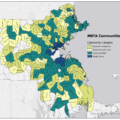The new proposal is just the most recent step in a process that reaches back almost a decade, culminating in the Master Plan (2015), the Housing Production Plan (2016) and the mixed-using zoning amendments of 2016. The Town has consistently proposed smart growth: more development along Arlington’s transit corridors to increase the tax base, stimulate local commerce, and provide more varied housing opportunities for everyone, including low and moderate income Arlingtonians. This year’s proposals are no head-long rush into change. Today’s debate is similar to the debate before Town Meeting three years ago. If anything, progress has been frustratingly slow. To realize the Master Plan’s vision of a vibrant Arlington with diverse housing types for a diverse population, we must stay the course on which we have been embarked for so long.
Related articles
(By Vince Baudoin and James Fleming)
Could Arlington be better using its curb space? Here are some ways the curb can be used to create green infrastructure, promote public safety and accessibility, support sustainable transportation, strengthen business districts, and enable new ‘car-light’ development.
Roughly six inches high and made of concrete or granite, the curb marks the edge of the roadway, channels runoff, protects the sidewalk, and gathers stray leaves. When not assigned any other use, the space in front of the curb it usually serves as free storage for personal automobiles.
Yet the humble curb is a limited resource that can serve the community in many more ways. Have you thought about how your town budgets its curb space? For that matter, has your town thought about how it budgets its curb space?
While Arlington mostly uses its curb space for parking, some areas have other curb uses designed to achieve a specific goal. Consider the streets you use often. Have you seen an unsolved problem, or a missed opportunity, that a different use of the curb could help solve?
Create green infrastructure
The Town has miles of paved roadway. When it rains or snows, water runs into storm drains, carrying salt, oil, and other pollutants with it. The storm drains dump these pollutants directly into long-degraded waterways such as the Mill Brook, Alewife Brook, and the Mystic River. The Public Works department struggles to keep grates clear and drains from overflowing.
One solution: Use the curb for more greenery! The curb can be extended to create a rain garden or tree planting strip. The rain garden helps slow runoff and filter the water before it enters the drain, while trees benefit from additional room for the roots to grow without damaging the sidewalk. A side benefit: narrowing the street encourages drivers to slow down, making neighborhoods safer.

Promote public safety and accessibility
Often, portions of the curb are set aside for public safety purposes. For example, a fire lane provides fire department access to key buildings, such as the high school, shown below. Fire hydrants also enjoy special curb status.
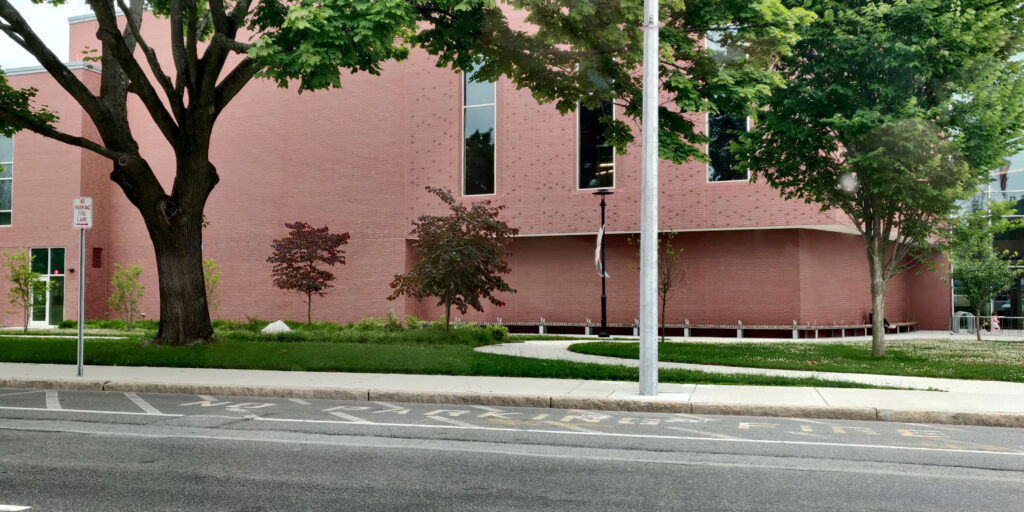
Other times, no-parking zones are established to enhance the free flow of traffic, such as here at Broadway Plaza:
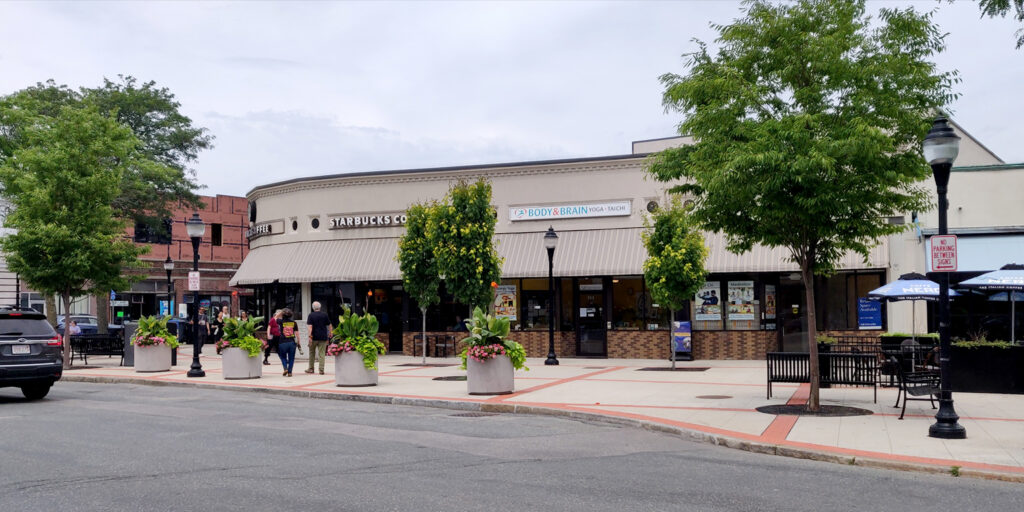
Where pedestrian crosswalks are present, a curb extension is a key safety enhancement. By narrowing the roadway, the curb extension encourages drivers to slow down and look for pedestrians. For pedestrians, it reduces the distance they must cross and prevents cars from parking directly next to the crosswalk and blocking visibility.
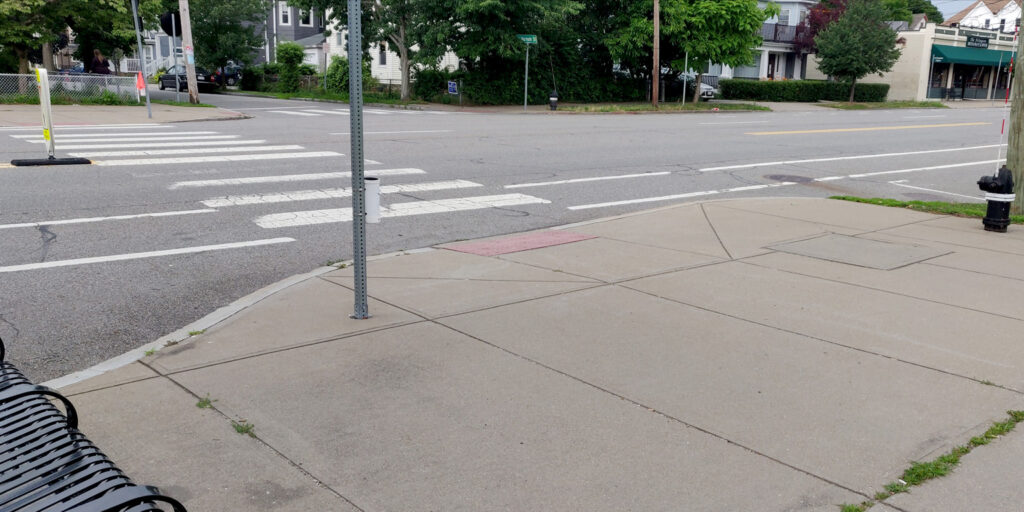
Finally, accessible parking spaces can be created along the curb. Arlington has at least 50 designated permit-only on-street parking spaces that provide convenient parking for residents with mobility issues or other disabilities.
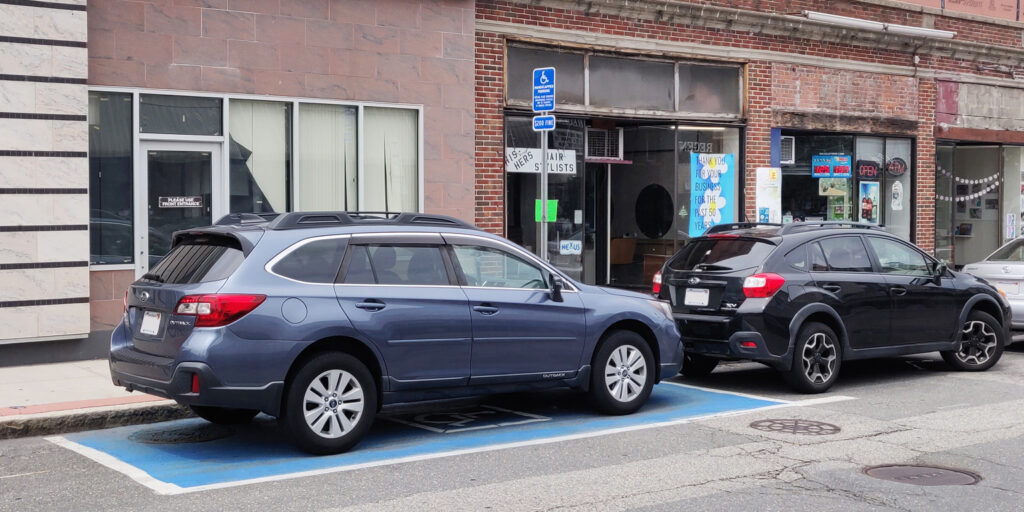
Support sustainable transportation
When the curb is mostly used for cars, it is easy to overlook how curbside facilities can enhance other forms of transportation.
In the space of one or two parked cars, this bikeshare station offers space for 11 bikes. However, because it is installed on the roadway, it must be removed every winter so that snow can be cleared. If the curb were extended, the bikeshare station could be used year-round. Another nice feature is bicycle parking: the space to park one car can be used to park six or more bicycles.

A bus stop allows buses to pull to the curb. In some cases, it is appropriate to extend the curb so the bus would stop in the traffic lane; otherwise, it may experience delays when it merges back into traffic.
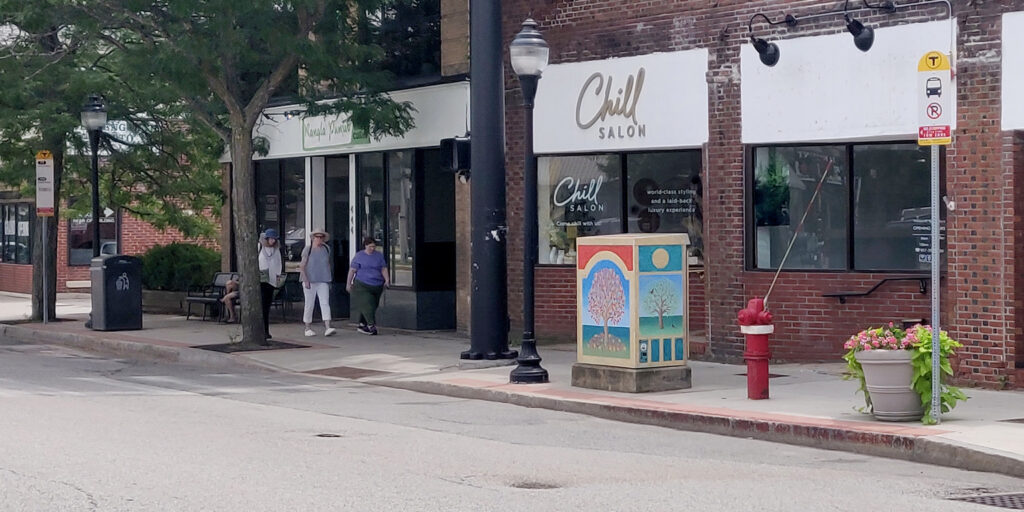
A bus priority lane provides a dedicated right of way for buses, helping to improve on-time performance. To date, these lanes extend only a few hundred feet into Arlington along Mass Ave. They have proven beneficial in many other communities.
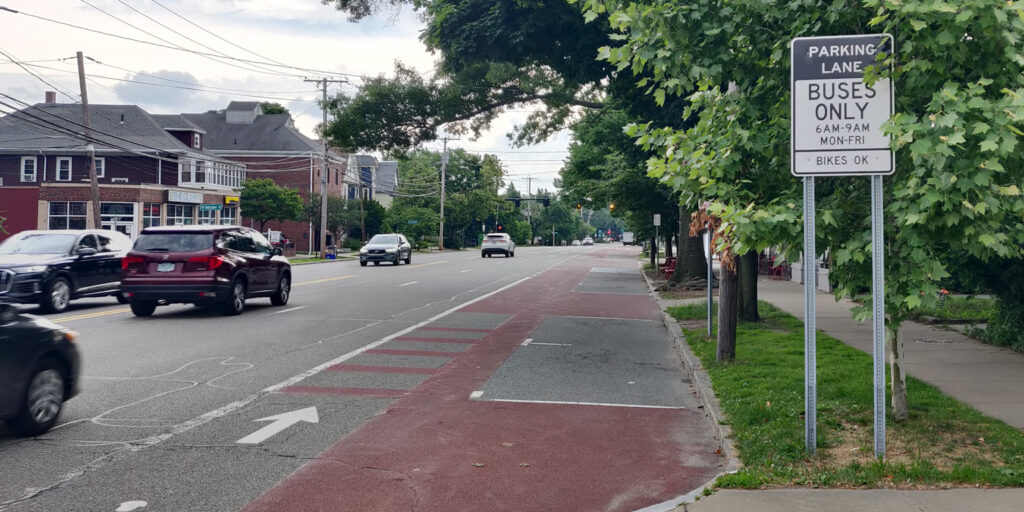
Bike lanes, particularly if they are separated from cars by a physical buffer, greatly enhance the safety and comfort of people traveling on two wheels.
But with a limited roadway width, adding bike lanes is difficult unless the community is flexible enough to consider consolidating curb parking on one side of the street, or moving it to side streets entirely.
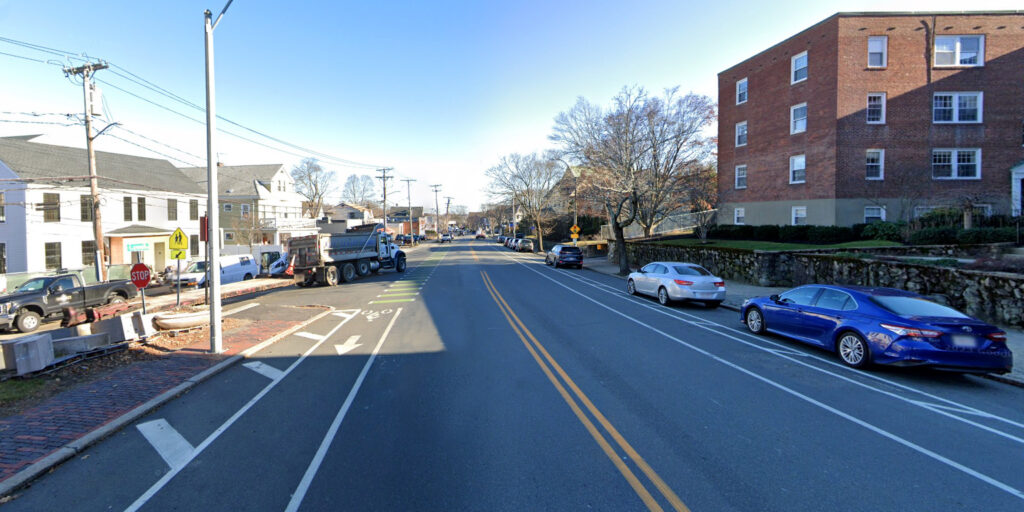
Finally, the Town could expand the use of on-street spaces for electric vehicle charging stations, such as this one on Park Ave:
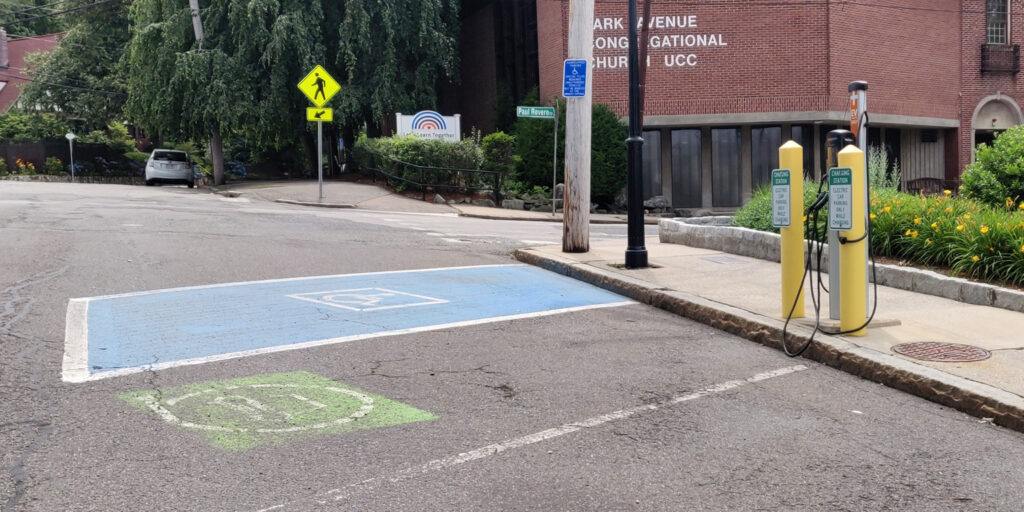
Strengthen business districts
Nowhere is the curb more valuable than in business districts. Businesses thrive when their customers have a convenient way to reach them. Metered parking encourages people to park, do their business, and move along so another patron can take that space. Revenue from parking meters can be spent to improve the business district–for example, by planting flowers and trees.
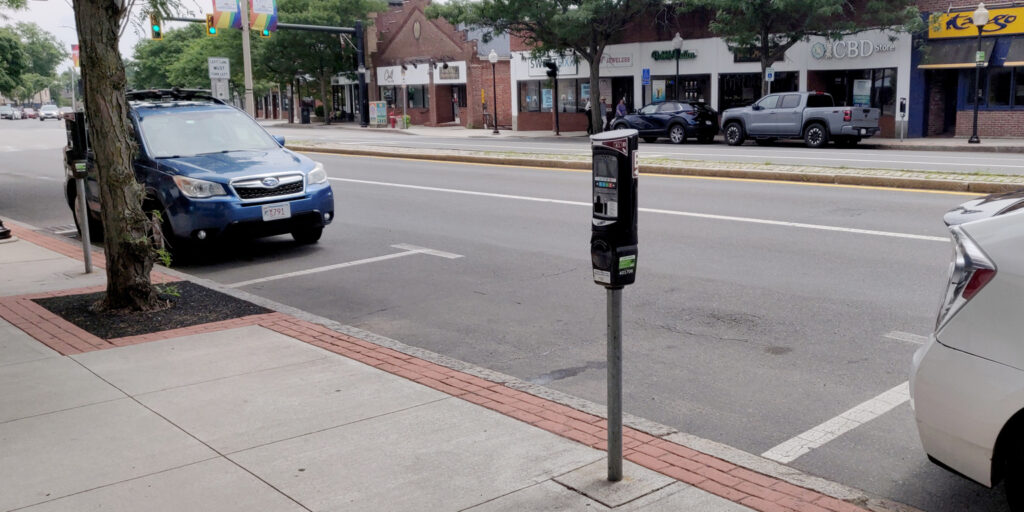
Metered parking is not the only valuable use of curb space in a business district. Outdoor dining is a way the Town can directly support its restaurants by enabling them to serve additional customers. Here is one example in Arlington Center:
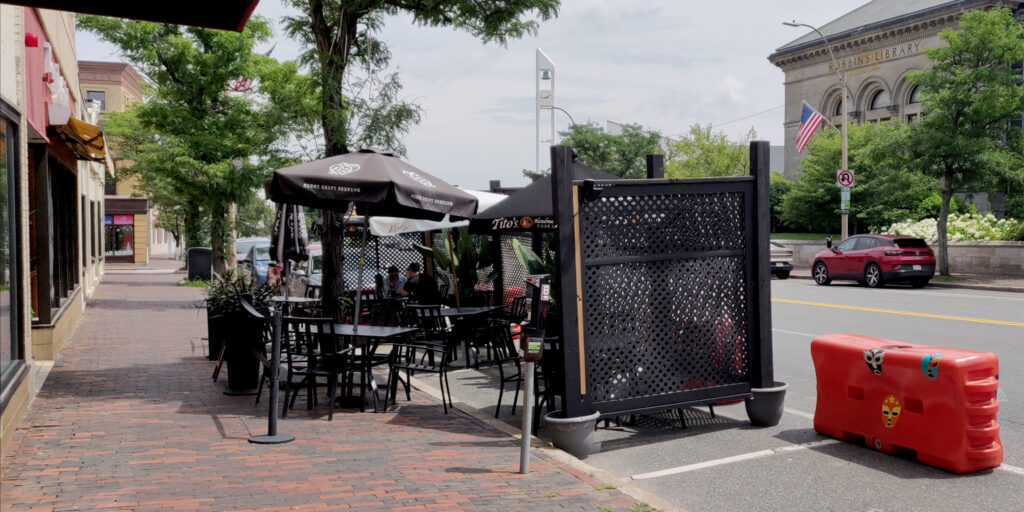
And in Arlington Heights:
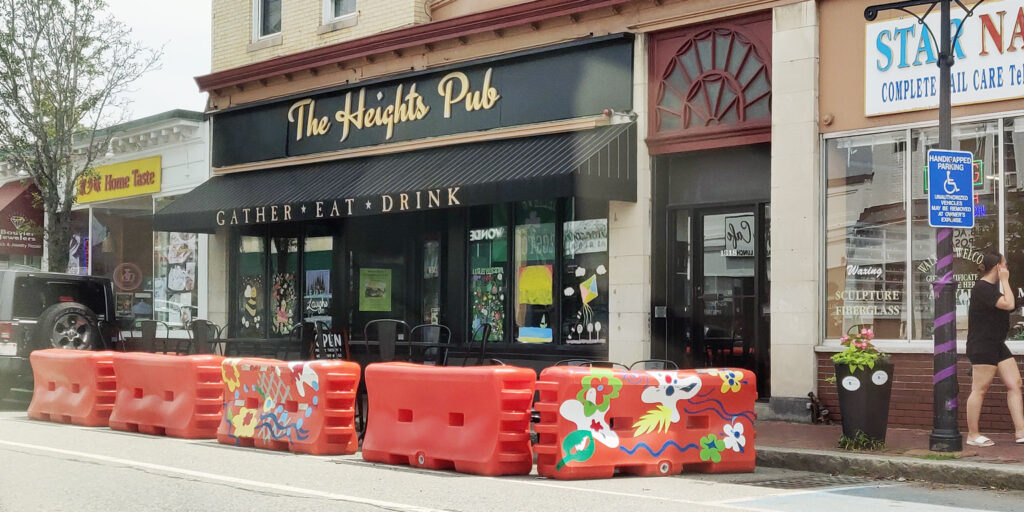
Other valuable curb uses in business districts include taxi stands and loading zones. Loading zones in particular are crucial to businesses’ success and help prevent the street from being clogged by early-morning delivery trucks, late-night food-delivery vehicles, and everything in between.
Enable new ‘car-light’ development
With high housing costs and a relatively small commercial tax base, Arlington could benefit from some kinds of development. However, land is valuable and lots are small, so if new buildings are required to have large parking lots, it is very difficult to build new homes and businesses. Plus, large parking lots bring more cars and more traffic. But better curb management can help resolve this dilemma, supporting car-light development that is more sustainable and affordable.
For example, on-street permit parking can enable nearby development with few or no off-street parking spaces. New housing or businesses are a better use of land than parking and will generate more property tax revenue. When parking permits are priced appropriately, they are available to residents who need them but discourage households from adding extra cars they do not need.
Take these hillside houses: access to on-street parking made it possible to build on a steep hillside, where it would have been too expensive and difficult to blast to create off-street parking.
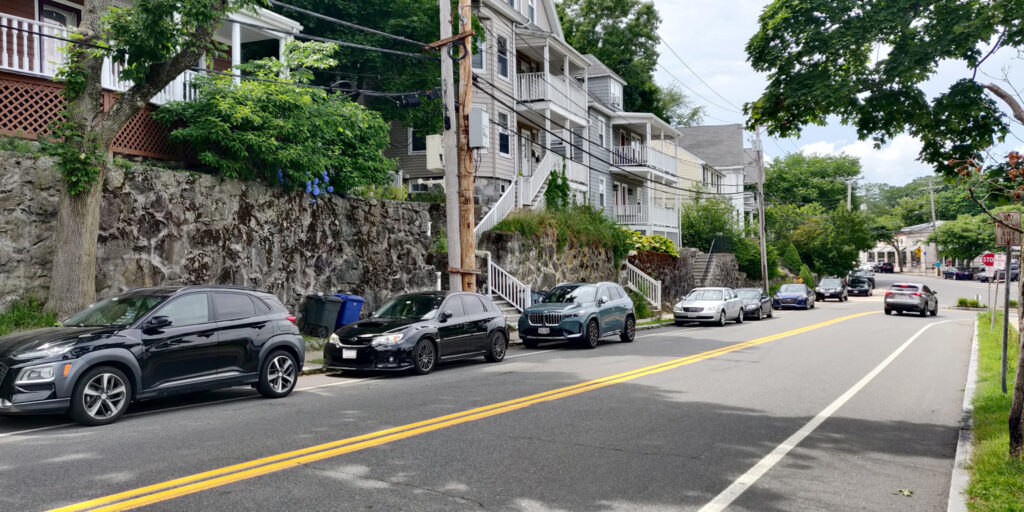
Conclusion
Ask your town leaders if they have a curb management strategy. Is the Town using its limited curb space in support of goals such as green infrastructure, public safety and accessibility, public transportation, local business, and car-light development?

It’s New Year’s eve and I’m determined to get my third and final “Arlington 2020” article written and posted before 2021 rolls in. I’ve written these articles to paint a picture of Arlington’s housing stock, and how our housing costs have changed over time. The first article looked at the number of one-, two-, and three-family homes and condominiums in Arlington. The second article looked at how the costs of these homes has varied over time.
In this article, I’m going to look at the per-unit costs for our different housing types. The per-unit cost is just the assessed value, divided by the number of units. For condos and single-family homes, the unit cost is simply the assessed value. For two-family homes, it’s the assessed value divided by two. For a ten-unit apartment building, it’s the assessed value divided by ten. We’ll look at the price ranges within housing types, as well as the general differences between them.
The information here doesn’t include residential units from Arlington’s 76 mixed-use buildings. (My copy of the assessor’s data doesn’t distinguish between residential and commercial units in these buildings; I’ll try to say more about them in 2021.) It also omits units owned by the Arlington Housing Authority.
Condominiums
Condominiums provide the most variety and cost diversity. A condo can be half of a duplex, or part of a much larger multi-family building. The low end of the scale tends to be 500–600 square foot units that were built in the 1960’s; the high end tends to be more spacious new construction.

This graph is a histogram, as are the others in this article. The horizontal axis shows cost per unit, and the vertical axis shows the number of units in each particular cost band.
The per-unit price distribution is
| min | 1st quartile | median | mean | 3rd quartile | max |
| $92,600 | $344,450 | $473,100 | $500,086 | $640,850 | $1,241,000 |
Single-family homes
Single family homes are heavily concentrated around the $700,000 mark. There’s very little available for less than a half million dollars.
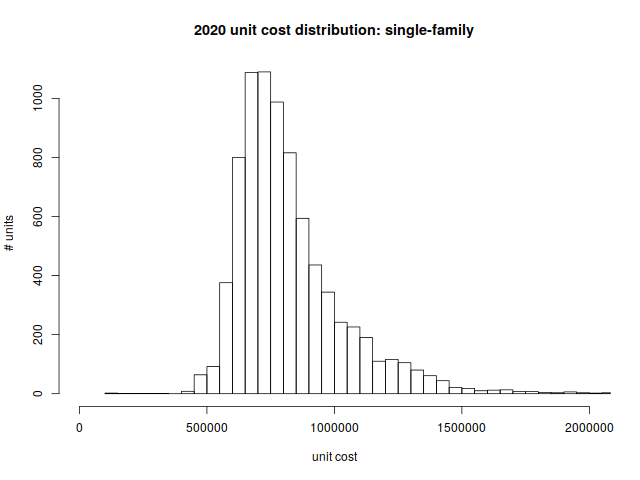
Per unit rice distribution:
| min | 1st quartile | median | mean | 3rd quartile | max |
| $103,700 | $679,900 | $771,900 | $825,172 | $908,750 | $3,232,700 |
The $103,700 single-family home deserves some explanation. The property straddles the border between Arlington and Lexington; it appears that the $103k assessed value reflects the portion that lies in Arlington.
Two-family Homes
Two-family homes are the bread and butter of East Arlington; they’re also common in the blocks off Mass ave near Brattle Square and the heights. Many of these homes are older and non-conforming, and they’re gradually being renovated and turned into condominiums.
As a reminder, these are costs per unit (as opposed to the cost of the entire two-family home).
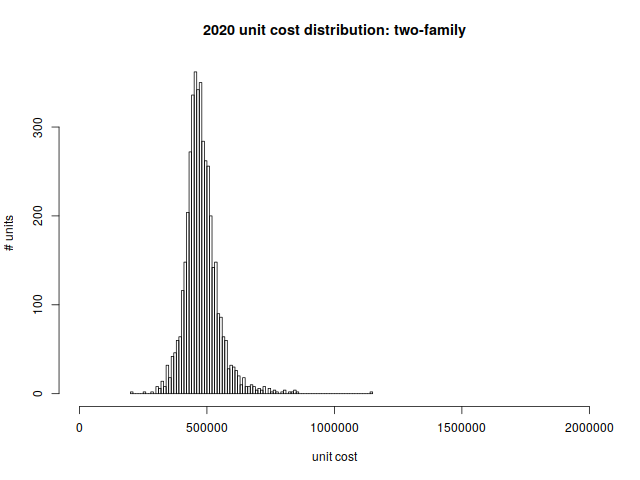
Per unit price distribution:
| Min | 1st quartile | median | mean | 3rd quartile | max |
| $209,050 | $440,550 | $472,000 | $479,175 | $508,588 | $1,140,450 |
Three-family Homes
Unlike Dorchester and Somerville, three-family homes are not a staple of Arlington’s housing stock. But we have a few of them. Most were built between 1906 and 1930.
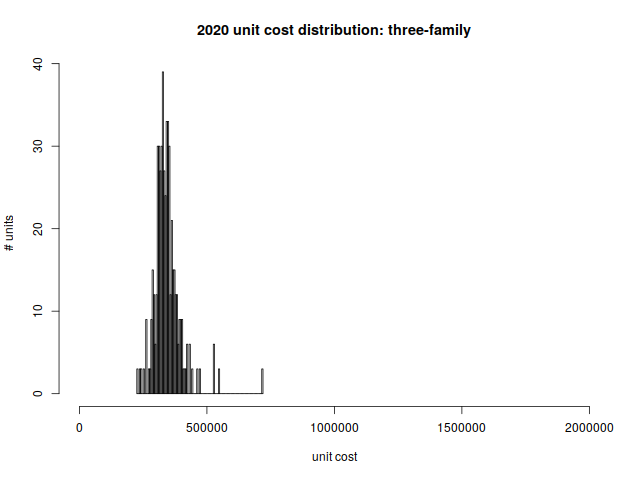
Per-unit price distribution:
| Min | 1st quartile | median | mean | 3rd quartile | max |
| $227,567 | $313,733 | $336,950 | $344,292 | $362,600 | $719,000 |
Small Apartments (4–8 units)
The majority of Arlington’s small apartment buildings were constructed during the first half of the 20th century. The most recent one dates from 1976.

Per-unit price distribution:
| Min | 1st quartile | median | mean | 3rd quartile | max |
| $154,950 | $202,950 | $227,775 | $231,619 | $255,775 | $403,875 |
Large Apartments (9+ units)
You’ll see three outliers in the per unit-cost distribution for large apartment buildings. These correspond to the newest apartment complexes in Arlington: The Legacy (2000), Brigham Square (2012), and Arlington 360 (2013).
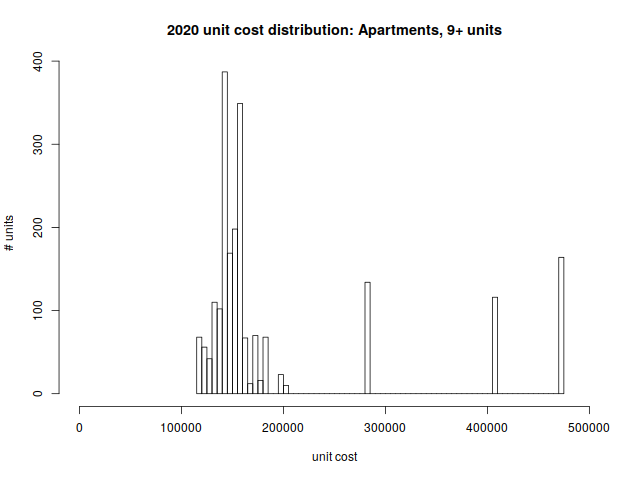
Per-unit price distribution:
| Min | 1st quartile | median | mean | 3rd quartile | max |
| $117,013 | $141,383 | $153,006 | $195,789 | $170,973 | $474,631 |
All combined
Finally, we’ll put it all together in one picture, representing nineteen-thousand and some odd homes in town.
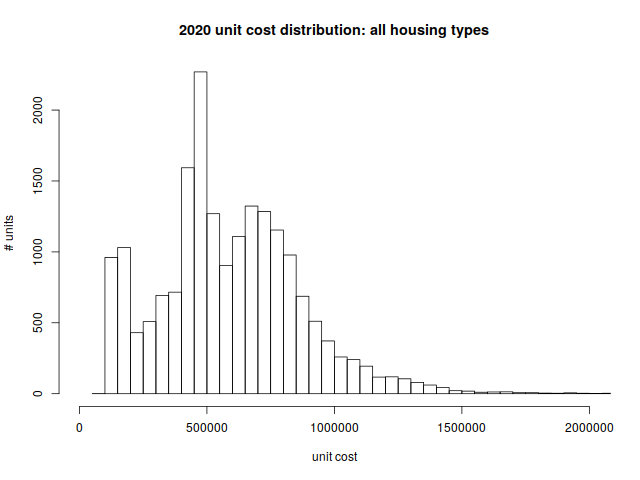
Per-unit price distribution:
| Min | 1st quartile | median | mean | 3rd quartile | max |
| $92,600 | $417,175 | $555,825 | $587,975 | $759,900 | $3,232,700 |
While there are lower-priced options available, a person coming to Arlington should expect to buy (or rent) a property that costs just shy of half a million dollars (or more).
Here is a spreadsheet with the cost distributions mentioned in this article.
(by Steve Revilak)
In 2021 the Massachusetts State Legislature passed the MBTA Communities act, which requires cities and towns served by the MBTA (aka “MBTA Communities”) to create districts where multi-family housing can be built by-right, without a disretionary approval process. The law was intended to help address the Commonwealth’s housing shortage, and to encourage more transit-oriented development. Building housing near transit and walkable areas has a lot of environmental benefits; it let’s people take trips without driving, lessens congestions, and cuts down on greenhouse gas emissions. It’s a solid strategey.
Arlington created its multi-family districts in the fall of 2023 and the Attorney General’s office approved them in June 2024. The laws have been on the books for just over a year — what kind of a difference are they making in Arlington?
2024 was a slow year for the MBTA Communities act in Arlington; there was one application which turned a two-family home on Belknap St into a pair of two-family homes, for a net change of two additional dwellings. 2025 has brought more activity. There are four applications under the review by the Arlington Redevelopment Board but none have been approved yet. These are:
- 225 Broadway, to convert a two-family home into a four-family,
- 126 Broadway, to convert a two-family home into a mixed use building with space for a business on the first floor, and 14 apartments,
- 18 Grafton, to convert a one-family home into a four-family, and
- 9-11 Robbins Road to convert a two-family home to nine apartments
There was an additional application to convert four apartments to five at 259 Broadway, but the applicant withdrew after their first hearing.
If all of these projects are approved, the net change will be an additional 26 homes, which represents a 0.1% increase relative to the 20,460 dwellings that Arlington had as of the 2020 census. It’s been a very slow trickle.
The MBTA Communities act was a meaningful reform which is just starting to make a difference. It’s bringing proposals for smaller multi-family homes that used to be the mainstay of our housing stock, but are generally rare today. However, the MBTA Communities Act is only one tool and Massachusetts will have to do more in order to build the 222,000 homes we need.
A municipality’s master plan is intended to set the vision and start the process of crafting the future of the municipality in regard to several elements, housing, history, culture, open space, transportation, finance, etc. Arlington began a very public discussion about these issues and the development of the Master Plan in 2012. In 2015, after thorough community wide discussion, the Master Plan was adopted by Town Meeting. This year, 2019, the focus is on passing Articles that will amend the current zoning bylaws in order to implement the housing vision that was approved in 2015.
from Karen Kelleher, Reporter
Interested in new policy developments on housing production in the Greater Boston area? The latest research from Mass Housing Partnership (MHP) is of interest. They just released (Dec. 18, 2019) in interactive map showing relative housing density around every mass transit and commuter rail station in the system, concluding that the region could add 235,000 units if every community allowed density as of right in the area around transit.
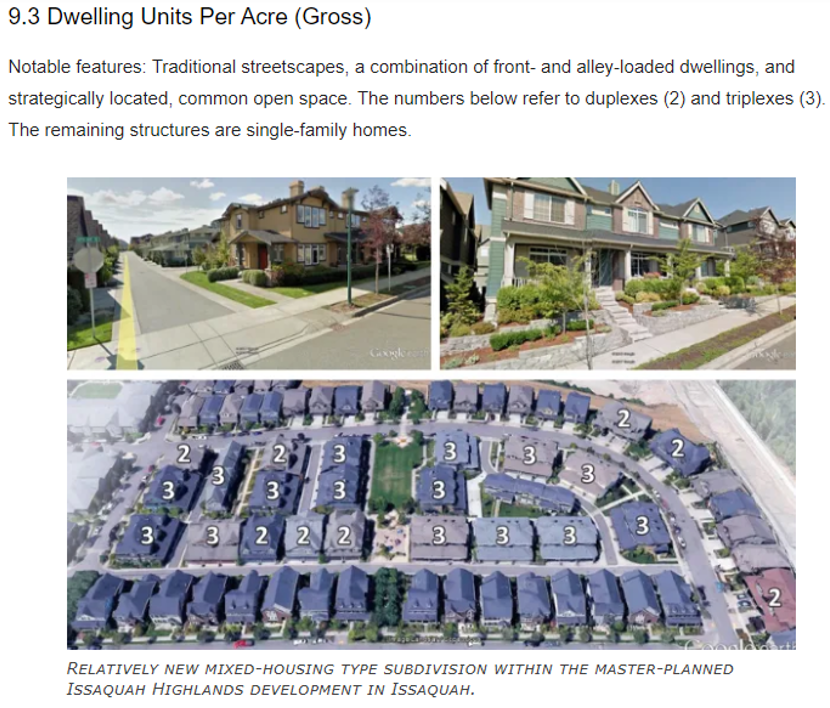
CHAPA has legislation pending that would require municipalities served by transit to allow higher density as of right within a certain distance from transit stations. You’ll see that the density around Alewife is not too bad in the context of the entire system.

This is mostly because of very high density in Cambridge near Alewife, but the density of two and three families in East Arlington shows better housing density than the sea of single family zoning around many commuter rail stops.
You can check it out here:https://www.mhp.net/news/2019/todex-research-brief
by Laura Wiener
If you’ve lived in Arlington for a while, your housing costs, whether you rent or own, might be well below what they are for newcomers. Perhaps you, or someone you know is experiencing scary annual rent increases, or would like to buy a house but can’t get near Arlington’s $1 million-plus median price tag.
Arlington, and much of the Commonwealth, has a shortage of housing that is driving up housing prices and increasing homelessness. Renters are particularly hard hit, with median rents over $2500/month. About 1/3 of Arlington’s renters pay more than 30% of their income for housing. In order to get that rent down to something affordable for a low-income household, subsidies are needed. Arlington has been very supportive of building affordable housing, using its CDBG (Federal Community Development Block Grant) and CPA (local Community Preservation Act) funds to that end. It has also worked cooperatively with the Arlington Housing Authority and Housing Corporation of Arlington in support of their affordable housing projects. These subsidy dollars are necessary but not sufficient for building affordable housing.
Land cost is one thing that makes building any housing expensive, and one way to decrease the cost of building affordable housing is to allow more units to be built on a given piece of land. But our zoning limits much of our town to single- and two-family homes on a lot. The Affordable Housing Overlay allows more units to be built on a lot, throughout the Town, and targets those who need it most—low-income households.
A zoning overlay is an alternative set of zoning requirements that can be applied on a piece of land. A builder can choose to build under the alternative Overlay Zoning rules, or under the original zoning, known as the Underlying Zoning. In this case, the proposed Affordable Housing Overlay Zoning can be applied anywhere, on any lot, if at least 70% of the units are priced to be affordable to a household at or below 60% of median income. If 70% of units are affordable, then the structure can be up to 2 stories taller than with the underlying zoning. In addition, any number of units can be built, so long as yard and setback requirements are met. One additional change is that the parking requirement would be a minimum of ½ space per unit. This reflects the actual parking usage at existing affordable housing owned by the Housing Corporation of Arlington. This proposal includes both rental and ownership units that are affordable.
A group of Arlington residents is proposing an amendment to our current zoning to include an Affordable Housing Overlay. This proposal will come before the Redevelopment Board for hearings in winter 2025 (probably during February or March), and then go to Town Meeting in spring 2025. There has already been one informational meeting on November 7 (slides and video), and there may be additional public informational meetings scheduled.
Dave Weinstock, an Arlington resident interested in affordable housing wondered about the concept of “developer math”. The math involved in planning an affordable housing projects is a problem that needs to get solved in order to have anything built here in Arlington, or anywhere. This topic comes up frequently in community discussions about the need for more housing.
Questions are raised around:
- 1- Why build so many units vs. smaller buildings
- 2- Why parking is costly and inefficient use of land
- 3- Why can’t more affordable or all affordable units be built?
- 4- The cost of subsidizing affordable units and how that may translate to higher rental rates/costs, etc.
Dave found a great Architecture and Development firm in Atlanta (Kronberg Urbanists + Architects, based in Atlanta GA) that lays out a nice presentation, includes sample proformas, and real life scenarios that may help us understand this piece of the puzzle better when evaluating any project and how developers may be incented to build certain types of projects or do certain types of work.
Here is a link, reformatted to be within this website, to the presentation, showing the varieties of choices, costs, formulas and outcomes developers consider before deciding if the project can be built: https://equitable-arlington.org/developer-math_kua_071420/
Much of our hope for more affordable housing depends on the market forces of capitalism and the willingness of developers to build for good, not just for profit. But the developers must be able to cover their costs. Many communities are highly skeptical of developers, assuming the community will get tricked, the developer will get greedy and the promised housing will be a disappointment. Trust is needed. But so is verification. We all need to learn the developer math.
What are the math factors that a developer considers before deciding to build affordable housing?

Here is a link to the original presentation. https://www.kronbergua.com/post/mr-mu-let-s-talk-about-math
Why Is This Our Issue & What Should We Do About It?
(presented by Adam Chapdelaine, Town Manager, to Select Board on July 22, 2019)
Overview

Since 1980 the price of housing in Massachusetts has surged well ahead of other fast growing states including California and New York. While the national “House Price Index” is just below 400, four times what an average house might have cost in 1980, a typical house in Massachusetts is now about 720% what it was in 1980. Median household income in the state has only increased about 15% during the same period. No wonder people in Arlington are feeling the stresses of housing costs if they want to live here and are feeling protective of the equity value time has provided them if they bought years ago.
In response to concerns about zoning, affordable housing and housing density, the Town joined the “Mayors’ (and Managers’) Coalition on Housing” to address these growing pressures. This 12 page slide deck presentation outlines the key data points, the number of low and very low income households in Arlington, the rate of condo conversion that is absorbing rental units, etc.
Solutions are offered including:
• Amendments to Inclusionary Zoning Bylaw
• Housing Creation Along Commercial Corridor – Mixed Use & Zoning Along Corridor
• Accessory Dwelling Units – Potential Age & Family Restrictions
• Other Tools Can Be Considered That Are Outside of Zoning But Have An Impact on Housing
Chapdelaine’s suggested next steps are:
• Continued Public Engagement
• Town Manager & Director of DPCD Meet with ARB
• Select Board & ARB Hold Joint Meeting in Early Fall
• ARB Recommends Strategies to Pursue in Late Fall/Early Winter
The Select Board approved the suggested next steps and a joint ARB/ Select Board meeting should be scheduled in the near future.
Note from Reporter: As a community, Arlington has long prided itself on its economic diversity. With condo conversions, tear downs leading to “McMansions”, higher paid workers arriving in response to new jobs, etc., Arlington is at great risk of losing this diversity that has long enriched the community. Retirees looking to downsize and young people who have grown up in Arlington looking for their first apartment are finding it impossible to stay in town. Shop keepers and town employees are challenged to afford the rising housing costs. With a reconsideration of zoning along Arlington’s transit corridors, Arlington NOW has an opportunity to create new village centers, like those recommended in the recent STATE OF HOUSING report. These village centers along our transit corridors could be higher, denser but also offer the compelling visual design and amenities desired by people who want to walk to cafes, shops and public transit.
